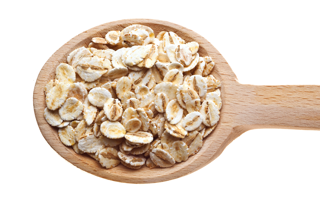
Even if you eat all organic, many oat-based foods such as cereal, granola, instant oats, and bars contain glyphosate, the toxic weed-killer in Roundup.
The independent study commissioned by the Environmental Working Group (EWG) measured levels of glyphosate in 45 samples of products made with conventional oats, and 16 samples made with organically grown oats. The results were shocking.
Thirty one of 45 samples made with conventional oats had 160 ppb or more of glyphosate, higher than what the EWG considers protective of children’s health.
In the organic products, glyphosate was detected at concentrations of 10 ppb to 30 ppb in 5 of 16 samples — well below the EWG health benchmark, but still present.
Organic farming prohibits use of glyphosate, so how does it get in organic food? It could drift on the wind from nearby conventional crop fields or enter by cross-contamination at a facility that handles non-organic crops.
According to the EWG, “The EPA has calculated that 1- to-2-year-old children are likely to have the highest exposure, at a level 2x greater than California’s No Significant Risk Level and 230x EWG’s health benchmark.”
Glyphosate: Not just an herbicide
Glyphosate is the active ingredient in Roundup, the most heavily-used weed killer worldwide. Used widely in the US on at least 70 crops from corn, soy, oats, and wheat, to fruits, nuts and vegetables, the EWG states that more than 250 million pounds of glyphosate is sprayed on American crops yearly.
A systemic herbicide, when applied to the foliage of broadleaf plants, weeds, and grasses, glyphosate is absorbed through the tissues to kill them.
While most of the public knows of Roundup as an herbicide, it is also commonly used in a pre-harvest application called “dessication.” Applied 7 to 10 days before harvest, it has the following effects:
- Acts as a drying agent on crops where uneven drying might risk ruining the harvest.
- During wheat harvest it can result in slightly higher crop yield by triggering plants to release more seeds.
- Pre-harvest application can initiate early harvest if weather conditions threaten the crop.
- Encourages earlier ripening for earlier replanting of a new crop.
- Reduces green material in fields that would otherwise strain farm machinery during harvest.
The “dessication” method was first suggested in the 1980s and has become routine in North America in the past 15 years. It is also catching on widely in the UK.
Most people assume glyphosate and Roundup are used only on GMO products, but it is also sprayed just before harvest on non-GMO oats, barley, wheat, and beans.
Cancer concern
While for years glyphosate was thought to be safe, recent studies have pointed to major health concerns from cancer to the disruption of gut bacteria that underlies many chronic illnesses.
While herbicide makers and the EPA deny glyphosate’s dangers, in 2015 the World Health Organization classified it as “probably carcinogenic to humans.”
While hundreds of other Roundup-related court cases are pending, in a 2018 landmark case, Monsanto was ordered by a California jury to pay $289 million in damages to a man dying of cancer, reportedly caused by repeated exposure to Roundup and other glyphosate-based weed killers in his job as a school groundskeeper.
Cancer not the only concern being researched
In addition to cancer risk, glyphosate also harms our gut bacteria.
Glyphosate also enhances the damaging effects of other chemical toxins in the environment. The effects manifest slowly over time damaging cellular systems throughout the body.
Monsanto claims that Roundup is harmless to animals and humans because its mechanism of action (called the shikimate pathway) is absent in all animals.
However, this pathway is present in bacteria, which is key for understanding how it can cause systemic harm in humans and animals.
Glyphosate disrupts beneficial bacteria thus allowing pathogens such as the highly toxic Clostridium botulinum to overgrow and take over the gut environment.
Disruption of the gut biome is an issue which underlies many diseases and conditions including:
- Gastrointestinal disorders
- Depression
- Diabetes
- Obesity
- Heart disease
- Autism
- Infertility
- Cancer
- Alzheimer’s disease
- Autoimmunity
In addition to the direct concerns for human health, environmental concerns exist as well:
- Mounting weed resistance to the toxin, requiring stronger and stronger applications.
- Demise of the monarch butterfly population.
- Honey bees exposed to glyphosate lose some of their beneficial gut bacteria and become more susceptible to infection and death from harmful bacteria.
Despite resistance from herbicide producers, glyphosate has been banned or restricted by the following countries:
- Belgium
- Bermuda
- Colombia
- Netherlands
- Sri Lanka
- El Salvador
- France
- Saudi Arabia
- Kuwait
- Qatar
- Bahrain
- Oman
- UAE
In addition, towns in many states have taken a stand against the chemical.
Organic or not, check your brands
What can you do to reduce the impact of glyphosate for yourself and your family? First, eat organic produce whenever you can. Secondly, look out for the following products from the EWG study and know their risk level:
Potentially dangerous to children:
- Back to Nature Classic Granola
- Quaker Simply Granola Oats, Honey, Raisin and Almonds
- Nature Valley Granola Protein Oats ‘n Honey
- Giant Instant Oatmeal Original Flavor
- Quaker Dinosaur Eggs, Brown Sugar, Instant Oatmeal
- Great Value Original Instant Oatmeal
- Umpqua Oats, Maple Pecan
- Market Pantry Instant Oatmeal, Strawberries & Cream*
- Cheerios Toasted Whole Grain Oat Cereal
- Lucky Charms (without marshmallows)
- Barbara’s Multigrain Spoonfuls, Original, Cereal
- Kellogg’s Cracklin’ Oat Bran oat cereal*
- Nature Valley Crunchy Granola Bars, Oats ‘n Honey
- Quaker Steel Cut Oats
- Quaker Old Fashioned Oats
- Bob’s Red Mill Steel Cut Oats*
Contains safe amounts of glyphosate:
- Back to Nature Banana Walnut Granola Clusters
- KIND Vanilla, Blueberry Clusters with Flax Seeds
- Kellogg’s Nutrigrain Soft Baked Breakfast Bars, Strawberry
- Nature’s Path Organic Old Fashioned Organic Oats
- Whole Foods Bulk Bin conventional rolled oats
- Bob’s Red Mill Organic Old Fashioned Rolled Oats
Contained no glyphosate in any tests:
- Nature’s Path Organic Honey Almond granola
- Simple Truth Organic Instant Oatmeal, Original
- Kashi Heart to Heart Organic Honey Toasted cereal
- Cascadian Farm Organic Harvest Berry, granola bar
- 365 Organic Old-Fashioned Rolled Oats
*This product underwent multiple tests and tested above the dangerous level in one or more and below the dangerous level in one or more.



Latest from the Blog
Autoimmune Disease Management with EBOO Therapy
July 17, 2024Autoimmune diseases, characterized by the immune system attacking the body’s own tissues, present significant challenges in treatment and management. Extracorporeal Blood Oxygenation and Ozonation (EBOO) therapy offers a promising adjunctive approach to managing autoimmune conditions. Functioning similarly to a dialysis machine, EBOO filters the blood to remove toxins and pathogens that may trigger autoimmune responses. […] Read more
Latest from the Blog
Detoxification and EBOO Therapy: Optimizing Cellular Health
Detoxification plays a crucial role in maintaining optimal health in today’s toxin-laden environment. Extracorporeal Blood Oxygenation and Ozonation (EBOO) therapy offers a sophisticated approach to detoxifying the bloodstream and enhancing overall well-being. Operating similarly to a blood filtration system, EBOO effectively removes toxins, pesticides, and chemicals that accumulate in the body, supporting the body’s natural […] Read more